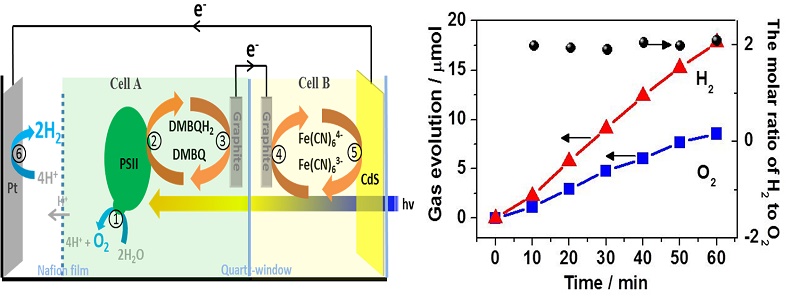Recently, our group got new success in the research of natural-artificial hybrid system for solar water splitting. The work was published as a full article in Energy Environ. Sci. ( DOI: 10.1039/C6EE03401B).
Solar overall water splitting to produce H2fuel is a promising approach to provide clean and renewable energy, which still remains a big challenge. Natural photosynthesis conducting efficient solar-to-chemical energy conversion can inspire us to design and construct artificial photosynthetic water splitting systems. Photosystem II (PSII) responsible for light-driven water oxidation in nature is considered as a benchmark in artificial water splitting systems for hydrogen production due to its excellent performance. Therefore, a bio-hybrid system integrating PSII with artificial photocatalytic materials is of interest to obtain a better understanding of both the natural and artificial photosynthetic reactions (Nat. Commun., 2014, 5, 4647; Angew. Chem. Int. Ed., 2016, 55, 9229).
The electron transfer from PSII to the artificial component plays a crucial role in the hybrid system. In this work, inspired from the multi-shuttle assisted electron transfer from PSII to PSI in natural photosynthesis, we proposed biomimetic electron transport from photosystem II to a photoelectrochemical cell for solar water splitting. PSII and the CdS-based PEC cell are connected by an ordered multi-step electron transfer pathway comprising two redox shuttles quinone/hydroquinone and ferricyanide/ferrocyanide coupled by a graphite-based galvanic cell.
The bio-hybrid cell was rationally arranged to separate PSII and CdS photoanode in the tandem light absorption manner, which can enhance the light utilization but also inhibit the fast photodamage of PSII under light iradiation. The hybrid system allows overall water splitting with 8.5 mmol O2 h-1 and 17.7 mmol H2 h-1 under AM-1.5G simulated solar light, corresponding to a solar-to-hydrogen efficiency of 0.34%. This work provides a strategy to construct more efficient electron transfer path in the design of artificial photosynthesis for overall water splitting and efficient solar energy storage.

This work has been financially supported by 973 National Basic Research Program of the Ministry of Science and Technology, National Natural Science Foundation of China and the Collaborative Innovation Center of Chemistry for Energy Materials (iChEM). (Text/Image by Zhen Li, Wangyin Wang)